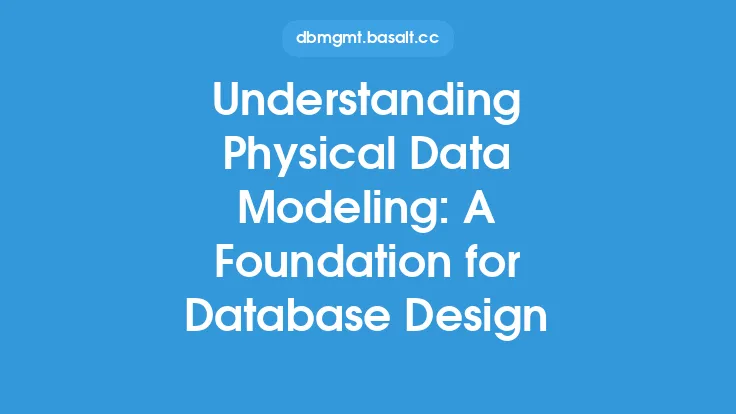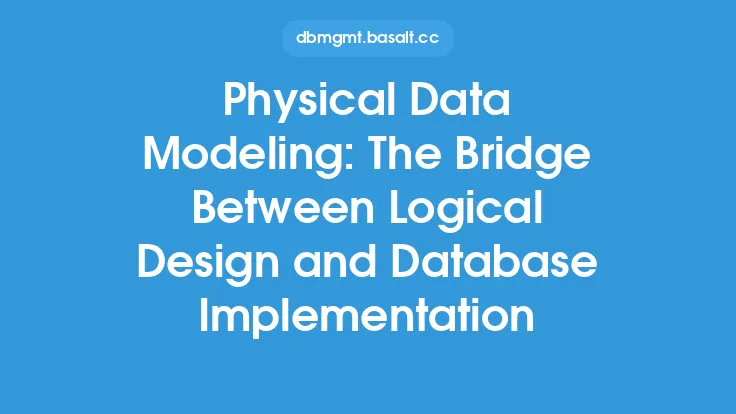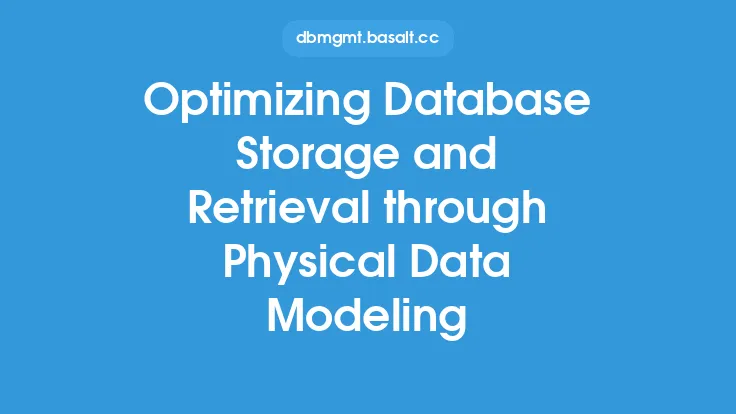When designing a database, one of the most critical steps is physical data modeling. This process involves creating a detailed, technical representation of the database's physical structure, including the relationships between different data entities, data types, and storage requirements. Physical data modeling is essential for ensuring database scalability and flexibility, as it allows designers to optimize the database's performance, storage, and retrieval capabilities.
Introduction to Physical Data Modeling
Physical data modeling is a crucial step in the database design process, as it translates the logical data model into a physical implementation. This involves defining the physical structure of the database, including the tables, indexes, views, and relationships between them. A well-designed physical data model ensures that the database can handle large volumes of data, support complex queries, and provide optimal performance.
Key Components of Physical Data Modeling
Physical data modeling involves several key components, including:
- Table design: Defining the physical structure of tables, including the data types, lengths, and storage requirements for each column.
- Indexing: Creating indexes to improve query performance, reduce data retrieval times, and enhance data integrity.
- View design: Defining views to provide a simplified interface to complex data, improve data security, and reduce data redundancy.
- Relationships: Establishing relationships between tables, including foreign keys, primary keys, and constraints to ensure data consistency and integrity.
- Storage management: Defining storage requirements, including disk space, memory, and I/O capacity to ensure optimal performance and scalability.
Benefits of Physical Data Modeling
Physical data modeling offers several benefits, including:
- Improved performance: A well-designed physical data model can significantly improve query performance, reduce data retrieval times, and enhance overall system responsiveness.
- Increased scalability: Physical data modeling allows designers to optimize the database's storage and retrieval capabilities, ensuring that the database can handle large volumes of data and support growing user populations.
- Enhanced flexibility: A flexible physical data model can adapt to changing business requirements, allowing designers to modify the database structure, add new tables or relationships, and support evolving data needs.
- Better data integrity: Physical data modeling ensures that data is consistent, accurate, and reliable, reducing errors, inconsistencies, and data redundancy.
Best Practices for Physical Data Modeling
To create an effective physical data model, designers should follow several best practices, including:
- Use standardized data types: Using standardized data types ensures consistency, reduces errors, and improves data integrity.
- Optimize indexing: Creating effective indexes can significantly improve query performance, reduce data retrieval times, and enhance data integrity.
- Use constraints: Establishing constraints, such as primary keys, foreign keys, and check constraints, ensures data consistency, accuracy, and reliability.
- Consider storage requirements: Defining storage requirements, including disk space, memory, and I/O capacity, ensures optimal performance and scalability.
- Test and refine: Testing and refining the physical data model ensures that it meets performance, scalability, and flexibility requirements.
Physical Data Modeling Techniques
Several physical data modeling techniques can be used to optimize database performance, scalability, and flexibility, including:
- Denormalization: Denormalizing data can improve query performance, reduce data retrieval times, and enhance overall system responsiveness.
- Data partitioning: Partitioning data can improve query performance, reduce data retrieval times, and enhance overall system responsiveness.
- Index clustering: Clustering indexes can improve query performance, reduce data retrieval times, and enhance overall system responsiveness.
- Data compression: Compressing data can reduce storage requirements, improve query performance, and enhance overall system responsiveness.
Tools and Technologies for Physical Data Modeling
Several tools and technologies are available to support physical data modeling, including:
- Entity-relationship modeling tools: Tools, such as ERwin, PowerDesigner, and Enterprise Architect, provide a graphical interface for designing and implementing physical data models.
- Database management systems: Database management systems, such as Oracle, Microsoft SQL Server, and IBM DB2, provide a range of features and tools to support physical data modeling.
- Data modeling software: Software, such as Data Architect, DBDesigner, and SchemaSpy, provide a range of features and tools to support physical data modeling.
Conclusion
Physical data modeling is a critical step in the database design process, as it translates the logical data model into a physical implementation. By following best practices, using standardized data types, optimizing indexing, and considering storage requirements, designers can create an effective physical data model that ensures database scalability and flexibility. By using physical data modeling techniques, such as denormalization, data partitioning, and index clustering, designers can optimize database performance, reduce data retrieval times, and enhance overall system responsiveness. With the right tools and technologies, designers can create a physical data model that meets the needs of the organization, supports growing user populations, and adapts to changing business requirements.





